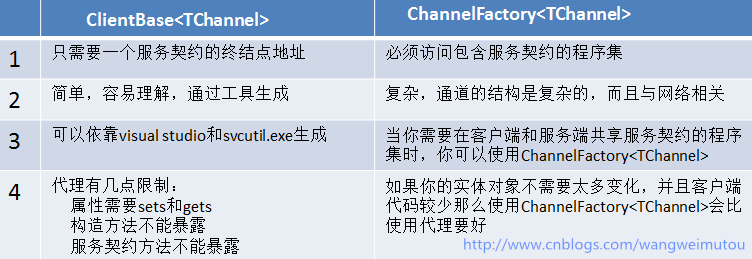WCF初探-10:WCF客户端调用服务
创建WCF 服务客户端应用程序需要执行下列步骤:
- 获取服务终结点的服务协定、绑定以及地址信息
- 使用该信息创建 WCF 客户端
- 调用操作
- 关闭该 WCF 客户端对象
WCF客户端调用服务存在以下特点:
- 服务和客户端使用托管属性、接口和方法对协定进行建模。 若要连接客户端应用程序中的服务,则需要获取该服务协定的类型信息。通常,我们使用Svcutil.exe(ServiceModel Metadata Utility Tool)来完成,也可以直接在客户端项目上引用服务地址完成。它们会从服务中下载元数据,并使用您选择的语言将其转换到托管源代码文件中,同时还创建一个您可用于配置 WCF 客户端对象的客户端应用程序配置文件
- WCF 客户端是表示某一个WCF服务的一个本地对象,客户端可以使用这种形式与远程服务进行通信。 WCF 客户端类型可以实现目标服务协定,因此当您创建一个服务协定,并对其进行配置后,就可以直接使用客户端对象调用服务操作。 WCF 运行时将方法调用转换为消息,然后将这些消息发送到服务,侦听回复,并将这些值作为返回值或 out 参数(或 ref 参数)返回到 WCF 客户端对象中。
- 创建并配置了客户端对象后,请创建一个 try/catch 块,如果该对象是本地对象,则以相同的方式调用操作,然后关闭 WCF 客户端对象。 当客户端应用程序调用第一个操作时,WCF 将自动打开基础通道,并在回收对象时关闭基础通道。 (或者,还可以在调用其他操作之前或之后显式打开和关闭该通道。)
- 不应该使用 using 块来调用WCF服务方法。因为C# 的“using”语句会导致调用 Dispose()。 它等效于 Close(),当发生网络错误时可能会引发异常。 由于对 Dispose() 的调用是在“using”块的右大括号处隐式发生的,因此导致异常的根源往往会被编写代码和阅读代码的人所忽略。 这是应用程序错误的潜在根源。
WCF客户端调用服务方式:
- WCF通信机制由它自身复杂的体系结构所决定,但WCF服务给我们提供了两种不同的机制来创建客户端程序调用,一种是ClientBase<TChannel>类,另一种是ChannelFactory<TChannel> 类。
- ClientBase<TChannel>:创建客户端代理类的基类,客户端代理类通过继承该基类,调用WCF的内部通信机制来实现WCF客户端与服务端的通信。代理类是一个公开单个CLR接口来表示服务契约的CLR类,代理类和服务契约很相似,但是他有着附加的方法来管理代理的生命周期和连接服务。通过visual studio 右键添加服务引用和通过svcutil.exe命令行工具生成的客户端都属于这种方式。(如果不熟悉svcutil.exe,请参照WCF初探-1:认识WCF)
- ChannelFactory<TChannel>:使用通道工厂类取决于你是否拥有描述服务契约的本地接口。最大的好处是你可以已扩展的方式更容易的修改通道的通信机制,如果你需要共享服务和客户端之间的契约组件,那么使用ChannelFactory<TChannel>可以更有效的节省时间,但客户端必须完成对服务契约组件的引用。
- ClientBase<TChannel>和ChannelFactory<TChannel>的差异:

WCF客户端调用服务示例:
- 解决方案如下图所示:

- 工程结构说明:
Service:类库程序,定义服务契约和实现,里面包含User数据契约和GetInfo()获取用户信息的服务契约方法。
IUserInfo.cs的代码如下:
using System.ServiceModel;
using System.Collections.Generic;
using System.Runtime.Serialization; namespace Service
{
[ServiceContract]
public interface IUserInfo
{
[OperationContract]
User[] GetInfo(int? id=null);
} [DataContract]
public class User
{
[DataMember]
public int ID { get; set; }
[DataMember]
public string Name { get; set; }
[DataMember]
public int Age { get; set; }
[DataMember]
public string Nationality { get; set; }
}
}
UserInfo.cs的代码如下:
using System;
using System.Collections.Generic;
using System.Linq;
using System.Text; namespace Service
{
public class UserInfo:IUserInfo
{
public User[] GetInfo(int? id=null)
{
List<User> Users = new List<User>();
Users.Add(new User { ID = , Name = "JACK", Age = , Nationality = "CHINA" });
Users.Add(new User { ID = , Name = "TOM", Age = , Nationality = "JAPAN" });
Users.Add(new User { ID = , Name = "SMITH", Age = , Nationality = "KOREA" });
Users.Add(new User { ID = , Name = "ALENCE", Age = , Nationality = "INDIA" });
Users.Add(new User { ID = , Name = "JOHN", Age = , Nationality = "SINGAPORE" }); if (id != null)
{
return Users.Where(x => x.ID == id).ToArray();
}
else
{
return Users.ToArray();
}
}
}
}
Host:控制台应用程序,添加对Service程序集的引用,寄宿服务程序。
Program.cs代码如下
using System;
using System.Collections.Generic;
using System.Linq;
using System.Text;
using Service;
using System.ServiceModel; namespace Host
{
class Program
{
static void Main(string[] args)
{
using (ServiceHost host = new ServiceHost(typeof(UserInfo)))
{
host.Opened += delegate { Console.WriteLine("服务已经启动,按任意键终止!"); };
host.Open();
Console.Read();
}
}
}
}
App.config代码如下:
<?xml version="1.0"?>
<configuration>
<system.serviceModel> <services>
<service name="Service.UserInfo" behaviorConfiguration="mexBehavior">
<host>
<baseAddresses>
<add baseAddress="http://localhost:1234/UserInfo/"/>
</baseAddresses>
</host>
<endpoint address="" binding="wsHttpBinding" contract="Service.IUserInfo" />
<endpoint address="mex" binding="mexHttpBinding" contract="IMetadataExchange"/>
</service>
</services> <behaviors>
<serviceBehaviors>
<behavior name="mexBehavior">
<serviceMetadata httpGetEnabled="true"/>
<serviceDebug includeExceptionDetailInFaults="true"/>
</behavior>
</serviceBehaviors>
</behaviors>
</system.serviceModel>
</configuration>
Client1:控制台应用程序,添加对服务终结点地址http://localhost:1234/UserInfo/的引用,设置服务命名空间为UserInfoServiceRef,生成客户端代理类和配置文件代码后,完成Client1对服务的调用。
Program.cs的代码如下:
using System;
using System.Collections.Generic;
using System.Linq;
using System.Text;
using Client1.UserInfoServiceRef; namespace Client1
{
class Program
{
static void Main(string[] args)
{
UserInfoClient proxy = new UserInfoClient();
User[] Users = proxy.GetInfo(null);
Console.WriteLine("{0,-10}{1,-10}{2,-10}{3,-10}","ID","Name","Age","Nationality");
for(int i=;i<Users.Length;i++)
{
Console.WriteLine("{0,-10}{1,-10}{2,-10}{3,-10}",
Users[i].ID.ToString(),
Users[i].Name.ToString(),
Users[i].Age.ToString(),
Users[i].Nationality.ToString());
} Console.Read();
}
}
}
Client2:控制台应用程序,使用svcutil.exe工具生成客户端代理类,在命令行中输入以下命令:
1.在运行中输入cmd打开命令行,输入 cd C:\Program Files (x86)\Microsoft SDKs\Windows\v7.0A\Bin
2.输入svcutil.exe /out:f:\ UserInfoClient.cs /config:f:\App.config http://localhost:1234/UserInfo/ (注意:端口号改成本机服务寄宿的端口号)
3.将生成的App.config和UserInfoClient.cs复制到Client2的工程目录下,完成Program.cs代码,代码和Client1的代码一样。
Client3:控制台应用程序,添加对Service程序集的引用,完成Program.cs代码,代码如下:
using System;
using System.Collections.Generic;
using System.Linq;
using System.Text;
using Service;
using System.ServiceModel;
using System.ServiceModel.Channels; namespace Client3
{
class Program
{
static void Main(string[] args)
{ EndpointAddress address = new EndpointAddress("http://localhost:1234/UserInfo");
WSHttpBinding binding = new WSHttpBinding();
ChannelFactory<IUserInfo> factory = new ChannelFactory<IUserInfo>(binding,address);
IUserInfo channel = factory.CreateChannel(); User[] Users = channel.GetInfo(null);
Console.WriteLine("{0,-10}{1,-10}{2,-10}{3,-10}", "ID", "Name", "Age", "Nationality");
for (int i = ; i < Users.Length; i++)
{
Console.WriteLine("{0,-10}{1,-10}{2,-10}{3,-10}",
Users[i].ID.ToString(),
Users[i].Name.ToString(),
Users[i].Age.ToString(),
Users[i].Nationality.ToString());
} ((IChannel)channel).Close();
factory.Close();
Console.Read();
}
}
}
查看服务运行结果,结果如下图所示:

- 客户端代理类,我们以svcutil.exe生成的代理类文件为例子,查看UserInfoClient.cs,代码如下:
namespace Service
{
using System.Runtime.Serialization; [System.Diagnostics.DebuggerStepThroughAttribute()]
[System.CodeDom.Compiler.GeneratedCodeAttribute("System.Runtime.Serialization", "3.0.0.0")]
[System.Runtime.Serialization.DataContractAttribute(Name="User", Namespace="http://schemas.datacontract.org/2004/07/Service")]
public partial class User : object, System.Runtime.Serialization.IExtensibleDataObject
{ private System.Runtime.Serialization.ExtensionDataObject extensionDataField; private int AgeField; private int IDField; private string NameField; private string NationalityField; public System.Runtime.Serialization.ExtensionDataObject ExtensionData
{
get
{
return this.extensionDataField;
}
set
{
this.extensionDataField = value;
}
} [System.Runtime.Serialization.DataMemberAttribute()]
public int Age
{
get
{
return this.AgeField;
}
set
{
this.AgeField = value;
}
} [System.Runtime.Serialization.DataMemberAttribute()]
public int ID
{
get
{
return this.IDField;
}
set
{
this.IDField = value;
}
} [System.Runtime.Serialization.DataMemberAttribute()]
public string Name
{
get
{
return this.NameField;
}
set
{
this.NameField = value;
}
} [System.Runtime.Serialization.DataMemberAttribute()]
public string Nationality
{
get
{
return this.NationalityField;
}
set
{
this.NationalityField = value;
}
}
}
} [System.CodeDom.Compiler.GeneratedCodeAttribute("System.ServiceModel", "3.0.0.0")]
[System.ServiceModel.ServiceContractAttribute(ConfigurationName="IUserInfo")]
public interface IUserInfo
{ [System.ServiceModel.OperationContractAttribute(Action="http://tempuri.org/IUserInfo/GetInfo", ReplyAction="http://tempuri.org/IUserInfo/GetInfoResponse")]
Service.User[] GetInfo(System.Nullable<int> id);
} [System.CodeDom.Compiler.GeneratedCodeAttribute("System.ServiceModel", "3.0.0.0")]
public interface IUserInfoChannel : IUserInfo, System.ServiceModel.IClientChannel
{
} [System.Diagnostics.DebuggerStepThroughAttribute()]
[System.CodeDom.Compiler.GeneratedCodeAttribute("System.ServiceModel", "3.0.0.0")]
public partial class UserInfoClient : System.ServiceModel.ClientBase<IUserInfo>, IUserInfo
{ public UserInfoClient()
{
} public UserInfoClient(string endpointConfigurationName) :
base(endpointConfigurationName)
{
} public UserInfoClient(string endpointConfigurationName, string remoteAddress) :
base(endpointConfigurationName, remoteAddress)
{
} public UserInfoClient(string endpointConfigurationName, System.ServiceModel.EndpointAddress remoteAddress) :
base(endpointConfigurationName, remoteAddress)
{
} public UserInfoClient(System.ServiceModel.Channels.Binding binding, System.ServiceModel.EndpointAddress remoteAddress) :
base(binding, remoteAddress)
{
} public Service.User[] GetInfo(System.Nullable<int> id)
{
return base.Channel.GetInfo(id);
}
}
我们可以看到客户端代理类中有着数据契约、服务契约,并且客户端代理类UserInfoClient继承ClientBase<IUserInfo>, IUserInfo,通过WCF内部通道机制完成对服务的调用。
public Service.User[] GetInfo(System.Nullable<int> id)
{
returnbase.Channel.GetInfo(id);
}
- ChannelFactory<IUserInfo>通道工厂通过:
EndpointAddress address = new EndpointAddress("http://localhost:1234/UserInfo");
WSHttpBinding binding = new WSHttpBinding();
ChannelFactory<IUserInfo> factory = new ChannelFactory<IUserInfo>(binding,address);
IUserInfochannel = factory.CreateChannel();
创建通道,完成对WCF服务的调用,注意:此处的工厂虽然提供了很多重载的方法,但我们这里属于客户端代码编程,因此我们读取不到配置文件信息,所以我把终结点信息
和绑定信息写到了代码中,如果想通过ChannelFactory<IUserInfo>读取配置文件信息,我们需要手动实现其扩展机制。这里以后的博文再做讨论
- 总结:我们通过实际的例子完成了对WCF客户端调用服务的几种方式的验证,也完成了代理类和通道工厂对服务调用的相关概念的诠释,在后面的博文中我将介绍客户端调用WCF服务的其他特性。
WCF初探-10:WCF客户端调用服务的更多相关文章
- WCF系列教程之WCF客户端调用服务
1.创建WCF客户端应用程序需要执行下列步骤 (1).获取服务终结点的服务协定.绑定以及地址信息 (2).使用该信息创建WCF客户端 (3).调用操作 (4).关闭WCF客户端对象 二.操作实例 1. ...
- WCF 客户端调用服务操作的两种方法
本节的主要内容:1.通过代理类的方式调用服务操作.2.通过通道的方式调用服务操作.3.代码下载 一.通过代理类的方式调用服务操作(两种方式添加代理类) 1.手动编写代理类,如下: 客户端契约: usi ...
- motan源码分析四:客户端调用服务
在第一章中,我们分析了服务的发布与注册,本章中将简单的分析一下客户端调用服务的代码及流程,本文将以spring加载的方式进行分析. 1.在DemoRpcClient类的main()方法中加载类: Ap ...
- java 从零开始手写 RPC (03) 如何实现客户端调用服务端?
说明 java 从零开始手写 RPC (01) 基于 socket 实现 java 从零开始手写 RPC (02)-netty4 实现客户端和服务端 写完了客户端和服务端,那么如何实现客户端和服务端的 ...
- jdk的wsimport方法实现webservice客户端调用服务
1.配置好jdk环境,打开命令行,输入wsimport回车能看到很多该命令的参数, -s:要生成客户端代码的存储路径 -p:对生成的代码从新打包 这两个最常用. 在打开的命令行中输入:wsimport ...
- signalR客户端调用服务端方法失败
现象: 在VS中修改集线器代码后,重新生成解决方案,客户端js调用服务端方法提示undefined. 检查后台代码未发现错误. 检查js代码未发现错误(方法名称符合小驼峰规范). 解决方法: 先清理解 ...
- 客户端调用服务端webservice的端口问题
今天有一个同事过来问:他有一个程序在A服务器上调第三方B服务器短信发送服务接口(webservice),无论是否发送成功,服务接口都会返回状态.现在客户要做每一个服务器 做入站端口管控,一切不必要的端 ...
- WCF初探-11:WCF客户端异步调用服务
前言: 在上一篇WCF初探-10:WCF客户端调用服务 中,我详细介绍了WCF客户端调用服务的方法,但是,这些操作都是同步进行的.有时我们需要长时间处理应用程序并得到返回结果,但又不想影响程序后面代码 ...
- WCF初探文章列表
WCF初探-1:认识WCF WCF初探-6:WCF服务配置 WCF初探-2:手动实现WCF程序 WCF初探-7:WCF服务配置工具使用 WCF初探-3:WCF消息交换模式之单向模式 WCF初探-8:W ...
随机推荐
- Boost源码剖析之:泛型指针类any
C++是强类型语言,所有强类型语言对型别的要求都是苛刻的,型别一有不合编译器就会抱怨说不能将某某型别转换为某某型别,当然如果在型别之间提供了转换操作符或是标准所允许的一定程度的隐式转换(如经过非exp ...
- JSP知识体系大全
Jsp动态网页 Web页面之间有3种关系: 包含 请求转发 重定向 l Jsp的运行原理:(3个) Jsp页面不能直接运行 1.容器调用jsp引擎编译jsp文件 成一个java文本(Servle ...
- html5,导航
<!DOCTYPE html><html lang="en"><head> <meta charset="UTF-8&qu ...
- SQL2005中的事务与锁定(六) - 转载
------------------------------------------------------------------------ -- Author : HappyFlyStone - ...
- 很不错的jQuery学习资料和实例
这些都是学习Jquery很不错的资料,整理了一下,分享给大家. 希望能对大家的学习有帮助. 帕兰 Noupe带来的51个最佳jQuery教程和实例, 向大家介绍了jQuery的一些基本概念和使用的相关 ...
- 批处理命令——for
[1]for命令简介 先把for循环与for命令类比一下,这样学习理解快. for 循环语句,一般格式如下: for (表达式1;表达式2;表达式3) { 循环体; } 1. 表达式1 一般为初始状态 ...
- atomic vs. nonatomic
Declaring a property atomic makes compiler generate additional code that prevents concurrent access ...
- C# 字符串string类型转换成DateTime类型 或者 string转换成DateTime?(字符串转换成可空日期类型)
在c#中,string类型转换成DateTime类型是经常用到的,作为基本的知识,这里在此做个小结.一般来说可以使用多种方法进行转换,最常用的就是使用Convert.ToDateTime(string ...
- osip状态机分析
转载于:http://blog.csdn.net/lbc2100/article/details/48342889 OSIP的核心是系统状态机,在不同情况下,系统处于不同的状态,在某一状态下当系统发生 ...
- linux查看磁盘系统df,du
可以用df命令轻松地查看所有已挂载磁盘的使用情况 df df -h 把输出的文件单位换成文件可读的单位 du 命令显示特定目录的使用情况 du -c 显示总用量 du -h 人类可读性 du -s 每 ...
